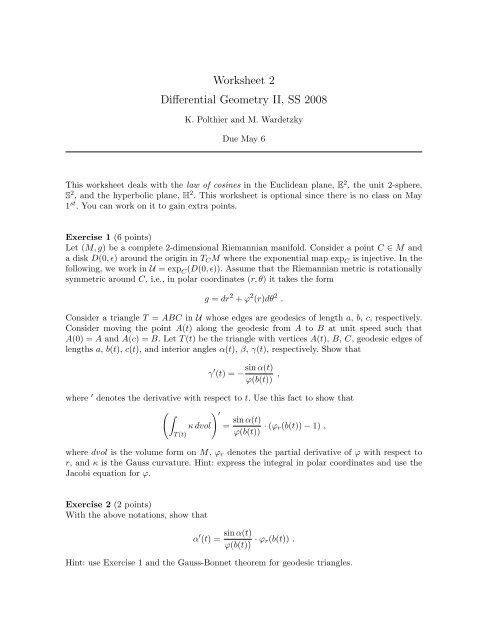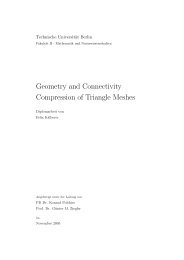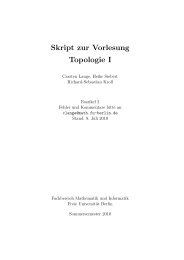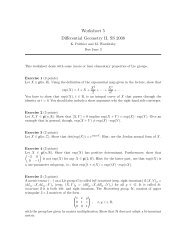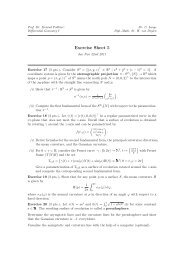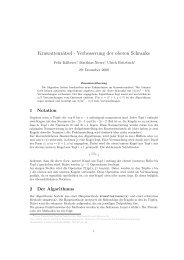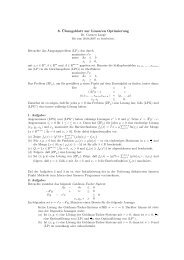Worksheet 2 Differential Geometry II, SS 2008
Worksheet 2 Differential Geometry II, SS 2008
Worksheet 2 Differential Geometry II, SS 2008
You also want an ePaper? Increase the reach of your titles
YUMPU automatically turns print PDFs into web optimized ePapers that Google loves.
<strong>Worksheet</strong> 2<br />
<strong>Differential</strong> <strong>Geometry</strong> <strong>II</strong>, <strong>SS</strong> <strong>2008</strong><br />
K. Polthier and M. Wardetzky<br />
Due May 6<br />
This worksheet deals with the law of cosines in the Euclidean plane, E 2 , the unit 2-sphere,<br />
S 2 , and the hyperbolic plane, H 2 . This worksheet is optional since there is no class on May<br />
1 st . You can work on it to gain extra points.<br />
Exercise 1 (6 points)<br />
Let (M, g) be a complete 2-dimensional Riemannian manifold. Consider a point C ∈ M and<br />
a disk D(0, ɛ) around the origin in TCM where the exponential map exp C is injective. In the<br />
following, we work in U = exp C(D(0, ɛ)). Assume that the Riemannian metric is rotationally<br />
symmetric around C, i.e., in polar coordinates (r, θ) it takes the form<br />
g = dr 2 + ϕ 2 (r)dθ 2 .<br />
Consider a triangle T = ABC in U whose edges are geodesics of length a, b, c, respectively.<br />
Consider moving the point A(t) along the geodesic from A to B at unit speed such that<br />
A(0) = A and A(c) = B. Let T (t) be the triangle with vertices A(t), B, C, geodesic edges of<br />
lengths a, b(t), c(t), and interior angles α(t), β, γ(t), respectively. Show that<br />
γ ′ sin α(t)<br />
(t) = −<br />
ϕ(b(t)) ,<br />
where ′ denotes the derivative with respect to t. Use this fact to show that<br />
′<br />
κ dvol =<br />
T (t)<br />
sin α(t)<br />
ϕ(b(t)) · (ϕr(b(t)) − 1) ,<br />
where dvol is the volume form on M, ϕr denotes the partial derivative of ϕ with respect to<br />
r, and κ is the Gauss curvature. Hint: express the integral in polar coordinates and use the<br />
Jacobi equation for ϕ.<br />
Exercise 2 (2 points)<br />
With the above notations, show that<br />
α ′ (t) =<br />
sin α(t)<br />
ϕ(b(t)) · ϕr(b(t)) .<br />
Hint: use Exercise 1 and the Gauss-Bonnet theorem for geodesic triangles.
Exercise 3 (3 points)<br />
With the above notations, let Φ(r) = r<br />
0 ϕ(s) ds, and let f(t) = Φ(b(t)). Show that<br />
f ′ (t) = −ϕ(b(t)) · cos α(t) , and<br />
Hint: use Exercise 2.<br />
f ′′ (t) = ϕr(b(t)) .<br />
Exercise 4 (6 points)<br />
Apply the above to M = E 2 , M = S 2 , and M = H 2 , to show that<br />
f ′′ (t) = 1 , f ′′ (t) + f(t) = 1 , and f ′′ (t) − f(t) = 1 ,<br />
respectively. Solve these ODEs using the initial conditions f(0) and f ′ (0). Plug t = c into the<br />
solutions to show the law of cosines:<br />
M = E 2 : a 2 = b 2 + c 2 − 2bc cos α ,<br />
M = S 2 : cos a = cos b cos c + sin b sin c cos α ,<br />
M = H 2 : cosh a = cosh b cosh c − sinh b sinh c cos α .


